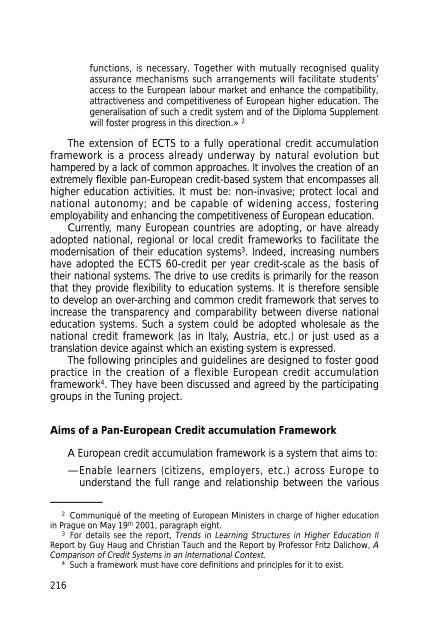Final Report Pilot Project - Relaciones Internacionales de la ...
Final Report Pilot Project - Relaciones Internacionales de la ...
Final Report Pilot Project - Relaciones Internacionales de la ...
Create successful ePaper yourself
Turn your PDF publications into a flip-book with our unique Google optimized e-Paper software.
functions, is necessary. Together with mutually recognised quality<br />
assurance mechanisms such arrangements will facilitate stu<strong>de</strong>nts’<br />
access to the European <strong>la</strong>bour market and enhance the compatibility,<br />
attractiveness and competitiveness of European higher education. The<br />
generalisation of such a credit system and of the Diploma Supplement<br />
will foster progress in this direction.» 2<br />
The extension of ECTS to a fully operational credit accumu<strong>la</strong>tion<br />
framework is a process already un<strong>de</strong>rway by natural evolution but<br />
hampered by a <strong>la</strong>ck of common approaches. It involves the creation of an<br />
extremely flexible pan-European credit-based system that encompasses all<br />
higher education activities. It must be: non-invasive; protect local and<br />
national autonomy; and be capable of wi<strong>de</strong>ning access, fostering<br />
employability and enhancing the competitiveness of European education.<br />
Currently, many European countries are adopting, or have already<br />
adopted national, regional or local credit frameworks to facilitate the<br />
mo<strong>de</strong>rnisation of their education systems 3 . In<strong>de</strong>ed, increasing numbers<br />
have adopted the ECTS 60-credit per year credit-scale as the basis of<br />
their national systems. The drive to use credits is primarily for the reason<br />
that they provi<strong>de</strong> flexibility to education systems. It is therefore sensible<br />
to <strong>de</strong>velop an over-arching and common credit framework that serves to<br />
increase the transparency and comparability between diverse national<br />
education systems. Such a system could be adopted wholesale as the<br />
national credit framework (as in Italy, Austria, etc.) or just used as a<br />
trans<strong>la</strong>tion <strong>de</strong>vice against which an existing system is expressed.<br />
The following principles and gui<strong>de</strong>lines are <strong>de</strong>signed to foster good<br />
practice in the creation of a flexible European credit accumu<strong>la</strong>tion<br />
framework 4 . They have been discussed and agreed by the participating<br />
groups in the Tuning project.<br />
Aims of a Pan-European Credit accumu<strong>la</strong>tion Framework<br />
216<br />
A European credit accumu<strong>la</strong>tion framework is a system that aims to:<br />
—Enable learners (citizens, employers, etc.) across Europe to<br />
un<strong>de</strong>rstand the full range and re<strong>la</strong>tionship between the various<br />
2 Communiqué of the meeting of European Ministers in charge of higher education<br />
in Prague on May 19 th 2001, paragraph eight.<br />
3 For <strong>de</strong>tails see the report, Trends in Learning Structures in Higher Education II<br />
<strong>Report</strong> by Guy Haug and Christian Tauch and the <strong>Report</strong> by Professor Fritz Dalichow, A<br />
Comparison of Credit Systems in an International Context.<br />
4 Such a framework must have core <strong>de</strong>finitions and principles for it to exist.


